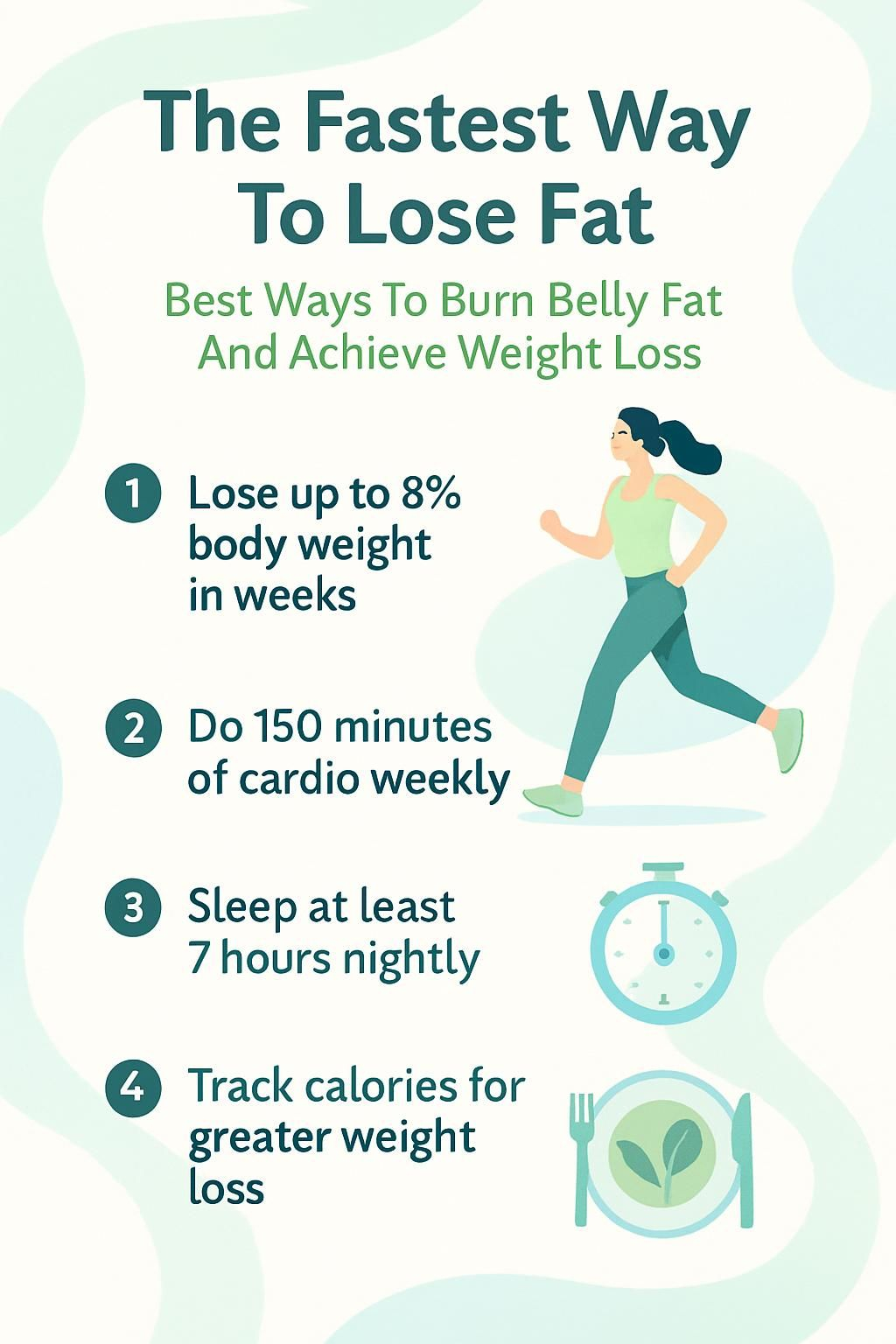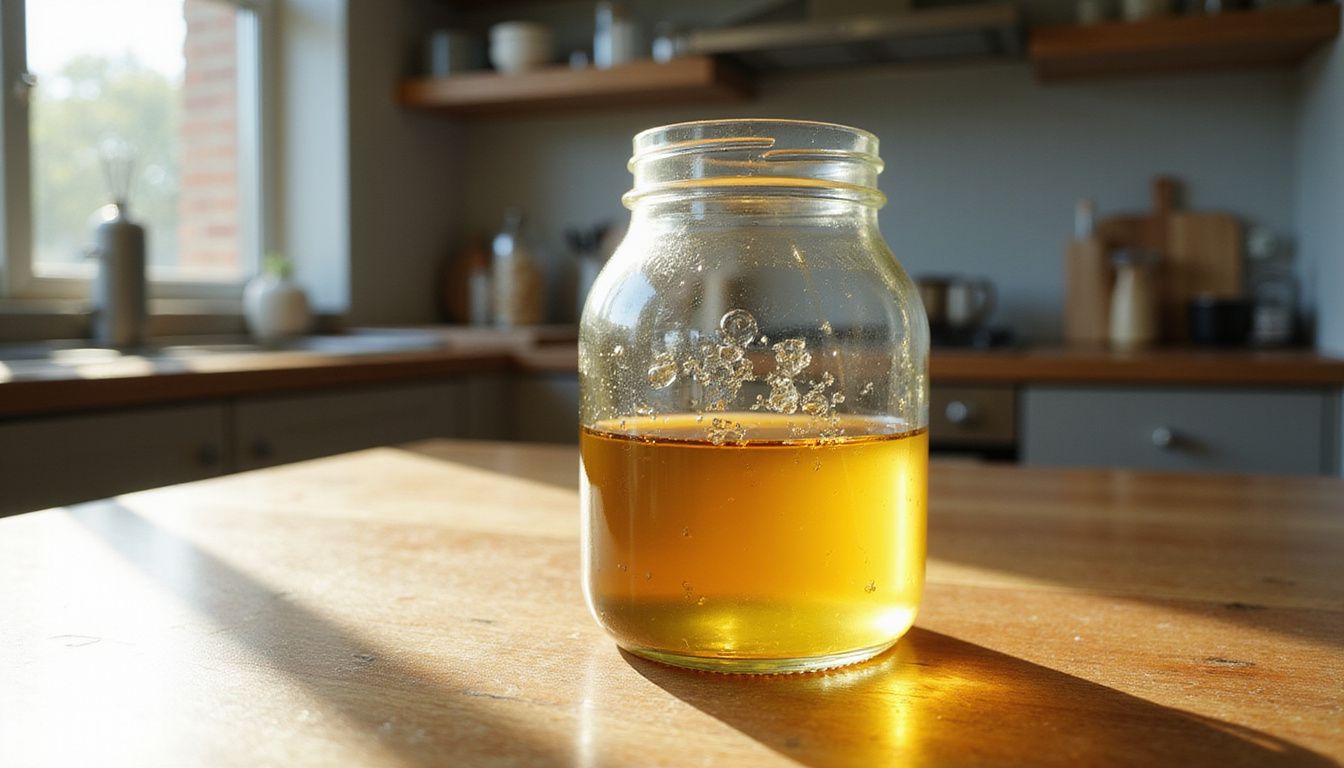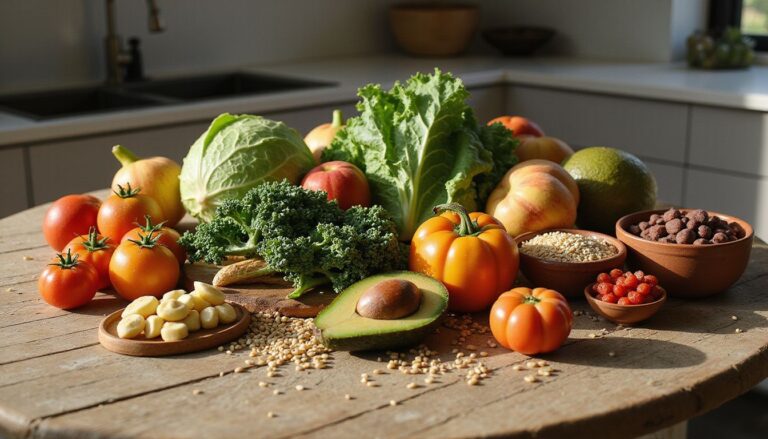The Fastest Way To Lose Fat: Best Ways To Burn Belly Fat And Achieve Weight Loss
Our Nutrition Assistant AI Suite will transform your body. You will lose fat, get toned, and build muscle. Gain confidence and optimal health.
Finding the fastest way to lose fat, especially belly fat, can feel discouraging. You face many choices, and it is hard to know what works. In this guide, you will learn how to improve your diet, move more, and build habits that support steady weight loss.
You will see simple ways to burn calories, use strength training and aerobic exercise, and shape daily routines that last. The goal is quick progress without losing balance in your life. Keep reading for practical, evidence-based steps you can start today.
Key Takeaways
- About 40 percent of U.S. adults live with obesity, raising risks for heart disease and type 2 diabetes, so safe and effective weight loss matters.
- A high protein, high fiber eating pattern plus regular cardio, about 150 minutes weekly, and strength training speeds fat loss and protects muscle.
- Intermittent fasting plans like 16:8 can reduce calorie intake and support 3 to 8 percent weight loss in several weeks.
- People who track food and activity with apps or wearables often lose more weight over 3 to 6 months.
- Consistent sleep, hydration, stress control, and avoiding late-night snacks improve long-term fat reduction.

Understanding Body Fat and How Fat Loss Works

Body fat stores energy and helps manage hormones that affect hunger and mood. Knowing how different fats act in your body helps you target belly fat and support healthy weight management.
What Are the Different Types of Body Fat?
Your body carries several kinds of fat, and each type behaves differently. White fat stores extra energy and cushions organs. When too much gathers deep in your belly as visceral fat, health risks rise.
Visceral fat sits around organs like the liver and intestines. High levels link to heart disease, type 2 diabetes, and high blood pressure. Subcutaneous fat rests under the skin. It is less risky than visceral fat, but too much can raise waist size.
Brown fat burns calories to create heat, especially in cold conditions. Beige fat acts like brown fat when activated by regular exercise. Over time, activity can help white cells act more like these calorie-burning cells.
Research suggests that regular physical activity can activate more metabolically active brown and beige tissues, which supports fat loss.
When I swapped refined grains for whole grains two years ago, my waist shrank before the scale moved much. That shift reminded me that fat type and food quality both matter.
How Does the Body Store and Burn Fat?
Your body stores excess calories in fat cells, which are part of adipose tissue. Insulin, a hormone that moves sugar from your blood into cells, drives this storage. Inside the cell, enzymes turn extra glucose into triglycerides for long-term storage.
When you eat fewer calories than you burn, or when you exercise, hormones like adrenaline signal fat cells to release stored triglycerides. These break down into fatty acids and glycerol, which travel in your blood to working tissues like muscles.
Regular physical activity increases how much energy you use each day, which helps reduce total body fat over time. Diet and exercise both guide whether stored fat becomes available for fuel.
Fat Storage vs. Fat Burning
| Process | Key Hormone | What Happens |
|---|---|---|
| Fat Storage | Insulin | Moves glucose into fat cells and converts excess to triglycerides |
| Fat Burning | Adrenaline | Breaks down triglycerides so muscles can use them for energy |
Visible results, such as losing 20 pounds, come from both nutrition changes and consistent movement. You guide the process each day by what you eat and how you move.
Optimal Dietary Strategies for Fat Loss
A healthy diet makes weight loss easier and more sustainable. Smart choices raise fullness, steady blood sugar, and protect muscle while you lose fat.
How Can I Reduce Processed Foods and Added Sugars?
Processed foods and added sugars slow weight loss and often raise belly fat. Cutting back lowers heart and diabetes risk while supporting a healthy body weight.
- Shop the store perimeter for fruits, vegetables, lean proteins, and whole grains instead of grabbing convenience food or sweet drinks.
- Cook at home with whole ingredients like olive oil, vegetables, beans, and lean meat so you control protein, salt, and sugar.
- Swap soda and sweet tea for water or unsweetened green tea to hydrate without extra calories.
- Read labels to spot added sugar and salt in cereals, sauces, snacks, and white bread.
- Choose whole grains such as brown rice, barley pasta, and high fiber bread instead of white rice or white bread.
- Use smaller plates to help manage portions. This simple step often cuts calories without feeling deprived.
- Snack on fruit, nuts, and salads with avocado or olives instead of packaged snacks high in sugar and poor quality oils.
- Limit treats to special events. Tracking snacks in an app can help you stick to whole foods most days.
- Pick plain Greek yogurt with berries or oatmeal with fruit over flavored yogurts or instant cereals.
High fiber and protein increase fullness, which supports steady calorie control. Over time, these habits help you lose fat and keep it off.
Why Should I Eat More Protein and Fiber?
Protein helps you feel full and protects muscle during weight loss. Muscle burns more calories at rest than fat, which supports a healthy metabolism. Good options include eggs, chicken breast, Greek yogurt, tofu, and fish.
Fiber slows digestion and reduces sharp rises in blood sugar. Beans, whole grains, vegetables, and berries are strong sources. People who eat more fiber tend to lose more fat over time.
When I began adding black beans to salads and an extra boiled egg at breakfast, mid-morning cravings dropped. I felt steady until lunch and found it easier to eat fewer calories.
What Are Healthy Fats and Why Are They Important?
Healthy fats include unsaturated fats from avocado, nuts, olive oil, and fatty fish. Your body needs these fats for cell growth, nutrient absorption, and hormone balance.
They boost fullness so you can reduce added sugars with less hunger. Monounsaturated and polyunsaturated fats also support heart health by lowering LDL, the so-called bad cholesterol. People who eat more plant-based fat sources often show a lower body mass index.
Including these fats supports your workouts too. You can lift weights or do cardio with better energy, which makes managing abdominal fat easier.
How Does Intermittent Fasting Help with Fat Loss?
Intermittent fasting limits eating to a set window, for example the 16:8 plan, which is a 16 hour fast and an 8 hour eating window. This timing helps your body use stored fat for fuel once it burns through stored carbohydrates.
Studies report that intermittent fasting can lower calorie intake without strict rules. One study found adults lost about 3 to 8 percent of body weight across 3 to 24 weeks. Many people also report fewer late-night snacks and less mindless eating.
Fasting may also help preserve lean muscle when paired with strength training and enough protein. If you take medications or have a medical condition, talk with your clinician before starting.
Effective Exercises to Eliminate Belly Fat
Exercise helps you burn calories now and later. Think of it as a daily deposit in your energy bank.
Which Cardio Exercises Burn Belly Fat Best?
Cardio raises your heart rate and increases your total energy burn. Consistency matters more than perfection. Pick activities you can repeat each week.
- Run or jog at a moderate pace for about 150 minutes per week. Start with brisk walks if running feels too hard.
- Cycle outdoors or on a stationary bike. It challenges the heart and large muscle groups.
- Swim for a joint friendly, full body workout that can reduce abdominal fat and build endurance.
- Jump rope to burn 10 to 15 calories per minute while improving coordination.
- Row to target the core, back, and legs while raising heart rate quickly.
- Try dance cardio such as Zumba for a fun way to stay consistent.
- Hike on hills to recruit more leg muscles and increase calorie burn.
Aerobic training trims belly fat more effectively when paired with smart food choices. Small changes each week add up.
How Does Strength Training Aid Fat Loss?
Cardio burns calories during the workout. Strength training builds muscle, which burns more calories all day. Lifting two or three times per week can increase your resting metabolic rate.
Strength work also protects lean tissue during a calorie deficit. That helps you avoid a big drop in daily energy needs. Last year, after I added two 30 minute lifting sessions weekly, my clothes fit better and my waist shrank faster.
Mixing cardio and lifting produces the strongest results. This combined approach supports long-term weight management instead of quick fixes.
What Is High-Intensity Interval Training (HIIT) and Its Benefits?
HIIT uses short bursts of hard effort followed by brief recovery. For example, sprint 30 seconds, then walk 60 seconds. Repeat the cycle for 15 to 20 minutes.
HIIT can burn more calories in less time than steady cardio. Studies show it may reduce belly fat more effectively than moderate exercise at a constant pace. It uses both aerobic and anaerobic energy systems, which keeps your metabolism elevated after you finish.
Many people also see improvements in heart health and blood sugar control. HIIT left me tired, yet energized. I noticed faster changes in muscle tone than with jogging alone.
What Core Exercises Strengthen the Abdominal Area?
A strong core improves posture and supports everyday movement. These exercises train deep and surface muscles that help shape the midsection.
- Plank: Hold a straight line from head to heels while bracing your core.
- Bicycle crunches: Lie flat, lift legs, and touch opposite elbow to knee in a pedaling motion.
- Leg raises: Lie on your back and raise both legs without bending your knees.
- Russian twists: Sit, lean back slightly, lift your feet, and rotate side to side with a medicine ball or dumbbell.
- Mountain climbers: Start in a push-up position and quickly drive knees toward your chest.
- Dead bug: Lie on your back, arms up, and lower opposite arm and leg while keeping your back flat.
- Standing side crunches: Bring one knee toward your elbow while crunching sideways, then switch sides.
I struggled until I added five minutes of planks to my mornings. After two weeks, my waist felt tighter and workouts felt stronger. Aim for at least 150 minutes of moderate activity per week, and place core work into that plan.
Lifestyle Adjustments for Ongoing Weight Loss
Daily habits shape results. Small, steady changes compound over time.
How Can Better Sleep Improve Fat Loss?
Quality sleep helps control the hormones that regulate hunger and fullness. Poor sleep often raises cravings for sugary, high calorie foods and lowers motivation to exercise.
Research suggests that people who sleep at least 7 hours per night lose more fat on a diet than those who sleep less. Simple steps like a set bedtime and a screen curfew can help. Even a single week of poor sleep can slow progress.
What Are Effective Stress Management Techniques?
Chronic stress raises cortisol, a hormone linked with belly fat storage. You can lower stress by practicing deep breathing, short mindfulness sessions, or yoga.
One study showed that people who used relaxation skills reduced more abdominal fat than those who did not. Light activity, such as a 10 minute walk, calms the nervous system and reduces cravings. I used to reach for snacks during deadlines. Now I journal for five minutes to reset.
Cutting screen time before bed also improves sleep, which softens the impact of daily stress on appetite and metabolism.
Why Is Staying Hydrated Important for Weight Loss?
Water supports every organ and helps your body burn energy efficiently. In one study, people who drank 500 milliliters of water before meals lost about 2 more pounds in 12 weeks than those who did not.
Hydration reduces mistaken hunger, which can lower snacking. Low carbohydrate plans increase fluid needs, so increase water as needed. Aim for light colored urine as a simple guide. If you sweat often, drink more to replace losses.
Quick Tips for Enhanced Fat Burning
Sometimes small moves create a helpful nudge. Use these to support your main plan.
How Do Green Tea and Black Coffee Boost Fat Burning?
Green tea contains catechins, antioxidants that may boost how your body uses energy. Caffeine in both green tea and coffee can raise calorie burn, especially during exercise.
Some studies suggest green tea increases daily energy use by about 3 to 4 percent. Black coffee can enhance workout performance, which helps you train harder and burn more fat. Keep them plain to avoid extra sugar and cream.
Can Adding Vinegar to My Diet Help Lose Fat?
Several studies suggest apple cider vinegar may support fat loss. In one trial, people who took one to two tablespoons daily lost about 2 to 4 pounds in 12 weeks versus a control group.
Vinegar may lower post-meal blood sugar and reduce appetite. Mix one tablespoon with water before meals or use it in salad dressings. Avoid drinking it straight to protect your teeth and stomach.
How Does Using Smaller Plates Control Portions?
Smaller plates make portions look larger, which helps you feel satisfied with less food. Research from Cornell shows that using a 10 inch plate instead of a 12 inch plate can cut calories by up to 22 percent.
People tend to finish most of what they serve. Smaller dishes help that habit work for you.
Why Should I Avoid Late-Night Snacking?
Your metabolism slows during sleep, so late snacks are more likely stored as fat. People who eat late often consume more total calories and choose more processed options.
Focus on balanced meals earlier in the day. That shift supports fat loss and makes plate size strategies work better.
Frequent Errors to Avoid During Fat Loss
A few common traps can stall progress. Knowing them helps you stay on track.
What Are the Risks of Relying Only on Crash Diets?
Crash diets slash calories so low that your body slows metabolism and sheds muscle. Many people regain weight within a year after extreme diets, which fuels a cycle of yo-yo dieting.
Severe restriction can also cause low energy, dizziness, and poor focus due to nutrient gaps. I tried a crash plan in high school and felt exhausted during classes and sports. Steady, balanced nutrition works better and supports health.
Why Is Maintaining Muscle Mass Crucial During Weight Loss?
Muscle burns more calories at rest than fat. Protecting muscle during a calorie deficit helps keep your metabolism stronger.
Enough protein and regular strength training help you lose belly fat without sacrificing lean tissue. You will also feel stronger for daily tasks and workouts.
What Happens If I Skip Meals?
Skipping meals can lower energy and trigger strong hunger later. Blood sugar may dip, which leads to irritability and overeating.
Studies show that people who skip breakfast tend to eat more later in the day. Regular, balanced meals help you control appetite and protect muscle during weight loss.
How Important Is Consistency for Fat Loss Success?
Consistency beats perfection. Routines that you follow most of the time build momentum and prevent rebounds.
People who stick with their plan at least 80 percent of the time often keep better results. Food logs and simple workout schedules make progress visible and maintain motivation. If you have an off day, reset at the next meal or workout.
Digital Resources to Accelerate Fat Loss
Digital tools make tracking easier, which often means better results. Use them to see patterns and adjust quickly.
What Are the Best Calorie-Tracking Apps?
MyFitnessPal lets you log meals, scan barcodes, and track nutrients. It connects with many fitness trackers. Lose It! offers a large food database and sets calorie budgets based on your goals. Cronometer tracks vitamins and minerals, not just calories.
I used MyFitnessPal for three months and learned how small snacks added up. A 2022 meta-analysis reported that people using calorie-tracking apps lost more weight than non-trackers. Most apps are free, with paid upgrades for extra features.
…
^ Harvey, J., Krukowski, R., and West, D. S. 2022. Obesity Reviews.
How Can Fitness Trackers and Wearables Help Me?
Fitness trackers record steps, heart rate, calories burned, and sleep. Popular devices like Fitbit and Apple Watch also send reminders to move and offer guided workouts.
Trends reveal what helps you most. I burn more calories on days after 8 hours of sleep, so I protect my bedtime. Some devices sync with food apps, which gives you a full view of diet and exercise together.
Leading research from Johns Hopkins found that people using fitness trackers lost an average of eight pounds more over six months than those who did not. Progress data keeps motivation high.
…
[Jakicic JM et al., JAMA, 2016.]
Which Online Workout Programs Are Recommended?
Trackers pair well with online training. You can follow expert plans at home or on the go.
Beachbody On Demand offers structured programs like P90X and 21 Day Fix. Peloton Digital provides live and on-demand classes in cycling, strength, HIIT, and running, even without a bike. Nike Training Club includes free bodyweight and mobility sessions with coaching videos.
Daily Burn supplies personalized plans, progress tools, and a supportive community. People who use interactive exercise apps are more likely to stay consistent than those who train alone. Flexible schedules and progress badges help you show up and keep going.
Keeping Motivation High Throughout Your Fat Loss Journey
Motivation rises and falls. The right systems keep you moving forward on hard days.
How Can I Set Realistic Fat Loss Goals?
Set measurable goals that match safe rates, about 1 to 2 pounds per week, as recommended by the CDC. Break big targets into weekly steps, then track habits with a calorie app or wearable.
Last year, I weighed in every Monday and kept a simple phone chart. Seeing small weekly drops felt rewarding and kept me focused.
What Are Effective Ways to Track Progress?
The scale is helpful, but it does not show the whole picture. Use several methods to capture true change.
Measure your waist weekly. This often reflects belly fat change better than weight alone. Take front, side, and back photos every two weeks under similar lighting. Log workouts and meals in an app such as MyFitnessPal. Smart scales can estimate body fat trends, and wearables track daily steps and activity.
Simple Progress Tracker
| Method | What It Measures | How Often |
|---|---|---|
| Weigh-ins | Body weight | 1 to 2 times per week |
| Waist measurement | Abdominal change | Weekly |
| Progress photos | Visual change | Every two weeks |
| Calorie tracking app | Diet and exercise logs | Daily |
Using multiple measures keeps small wins visible, which reduces frustration during plateaus. Reward milestones to reinforce effort.
How Should I Celebrate My Weight Loss Achievements?
Plan healthy rewards that support your goals. Buy a new workout shirt, book a class you want to try, or schedule a relaxing massage.
Share milestones with supportive friends or family. Plan an active outing, like a hike or bike ride. Keep a journal or photo album of your wins. These simple celebrations make the journey feel meaningful.
Conclusion
Fat loss comes from steady habits, not short-term tricks. Balanced nutrition, regular exercise, quality sleep, and stress control work together to reduce belly fat and improve health.
Simple actions like tracking calories, drinking water, and closing the kitchen after dinner can create real momentum. Use digital tools to stay accountable, and set realistic goals you can measure.
Each small choice stacks up. If you have a medical condition, are pregnant, or take medicines, talk with a healthcare professional before starting a new diet and exercise plan. This article is for education only. With consistent effort, you can lose weight safely and keep it off.
FAQs
1. What is the fastest way to lose fat and burn belly fat?
Research shows that a mix of regular aerobic exercise, strength training, and a balanced diet with fewer calories than you burn leads to faster fat loss. Studies from the National Institutes of Health confirm that people who combine these methods see greater results in both total weight loss and reduced abdominal size.
2. Which foods help achieve weight loss most effectively?
Whole grains, lean poultry, fish, beans, fruits, and vegetables support healthy weight management. A table below lists some examples:
Food Group | Example Foods | Calories per Serving
—————— | ———————- | ——————–
Lean Protein | Chicken breast | 165 kcal (3 oz)
Vegetables | Broccoli | 31 kcal (1 cup)
Whole Grains | Brown rice | 216 kcal (1 cup)
Fruits | Apples | 95 kcal (medium)
Choosing these foods helps control hunger while providing nutrients your body needs.
3. How much exercise do I need for effective belly fat reduction?
Experts recommend at least 150 minutes each week of moderate-intensity activity such as brisk walking or cycling along with two days of muscle-strengthening activities like resistance exercises or yoga. The American Heart Association supports this routine for improved health outcomes.
4. Can personal experience influence success in losing belly fat?
Yes; tracking food intake and physical activity can improve motivation and accountability based on clinical studies published in Obesity Reviews journal. For example, when I started recording my meals daily using an app last year, I noticed more consistent progress toward my goals compared to previous attempts without tracking.
Summary: Combining structured exercise routines with mindful eating habits produces reliable results for burning belly fat and achieving lasting weight loss according to credible research sources.







